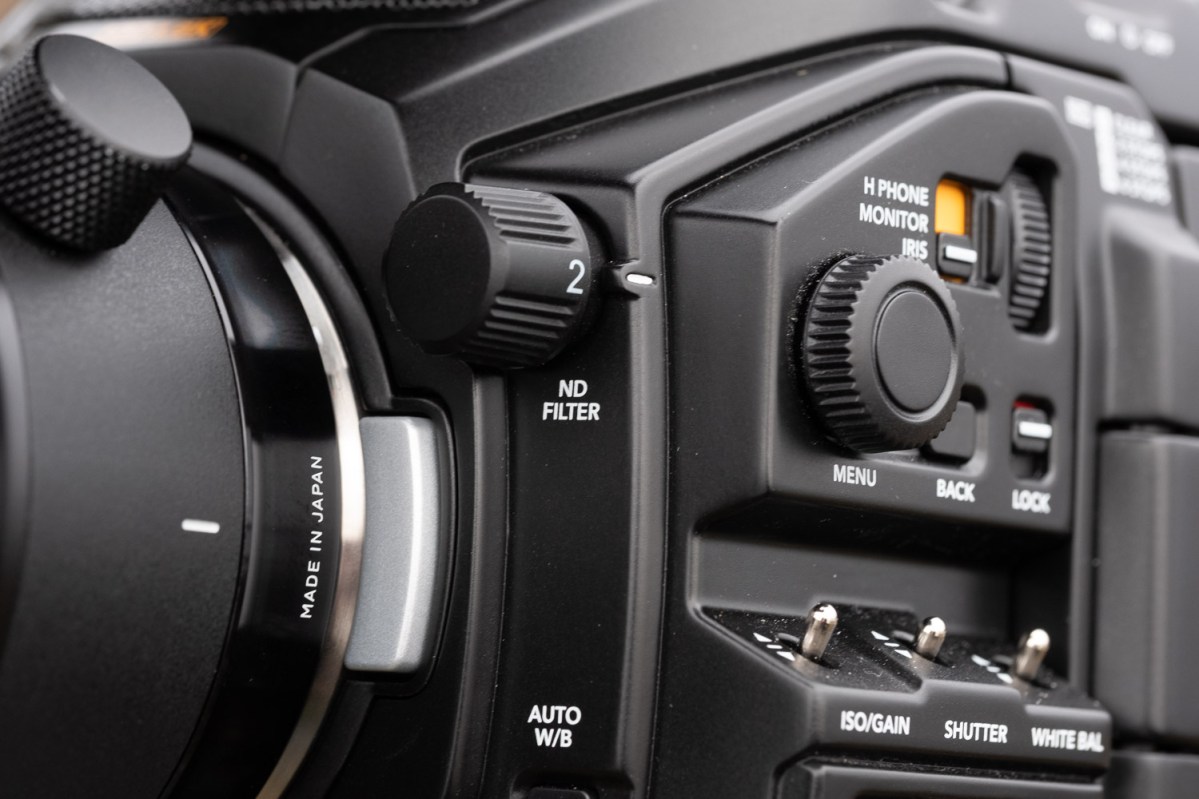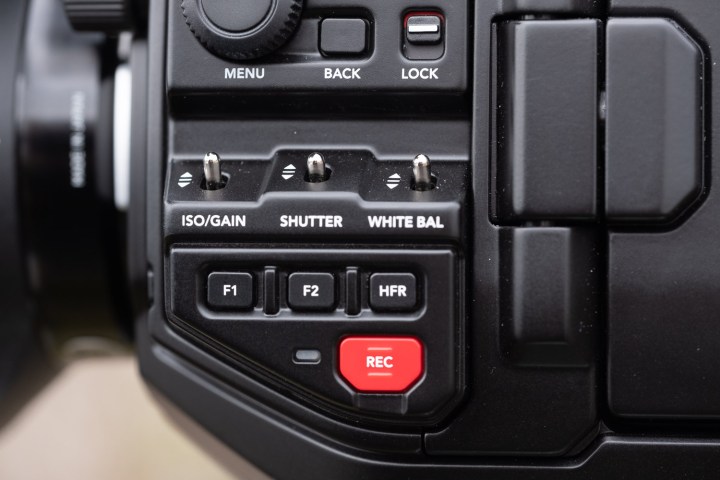“The hardware is great, but Blackmagic RAW is a game-changer for indie and small-budget productions.”
- Blackmagic RAW codec
- 120 fps 4.6K
- Approachable user interface
- Built-in ND filters
- Awkward iris dial placement
- Some nickel-and-diming for accessories
“Bear” is a fitting name for the beast that is Blackmagic Design’s Ursa Mini Pro 4.6K G2, the company’s flagship cinema camera. But it’s a well-trained bear. Where other such machines appear terrifying in their complexity, the Ursa is docile. I’ve never been so dumbfounded by how easy a camera makes professional-caliber shots.
It feels like cheating, really. Turn it on, point it at something, press record, and out comes a shot ready for the big screen. If you know how to use a DSLR, you can figure out the Ursa in minutes.
Well, OK, it takes a little more work than that. You have to first decide which record button to press — there are, like, four of them. But once you’ve settled on your favorite, there’s nothing else in the way of living out your directorial dreams. From a technical standpoint, anyway.

Despite my techno-lust, the Ursa remains out of my league — and yet, not outlandishly beyond my budget. At a fiver under $6,000, I won’t be buying one anytime soon, but it’s a heck of a lot more affordable than similar cinema cameras from other manufacturers.
I’m not sure what makes a Red or Arri, the cameras of choice in Hollywood, worth tens of thousands more. But as someone who shoots video on a hybrid mirrorless camera, I can see the value in moving up to the Ursa. Six grand is a lot of money. Yet here, with the Ursa, it feels like a bargain.
Design and user interface
The original Ursa Mini Pro 4.6K was Blackmagic’s first camera that felt finished. After a few years of striking and bizarre designs, Blackmagic landed on a familiar shape that straddles the gap between cinema camera and ENG camcorder.
The G2 refines the formula with small but important improvements to the electronics, without changing what already worked. The result is not only a pro-level video camera that puts my aging-but-trusty Fujifilm X-T2 to shame, but the best value in the cinema world, period.

Blackmagic hits a low price by selling you a bare-bones camera. A viewfinder, battery, and handle are all add-ons that can add hundreds or thousands to the price. That can make cameras like Canon’s C200, at $6,500 with viewfinder and battery included, more affordable. But the Ursa has a hardware edge, with 15 stops of advertised dynamic range compared to the Canon’s 13, higher frame rates, and a more versatile RAW format.
Although not new, a key feature of the Ursa — and many dedicated video cameras — is the built-in neutral density filter control. You can select 0, 2, 4, or 6 stops of density by turning a dial, meaning you never have to fuss with a screw-on lens filters. Think sunglasses for your camera. ND filters reduce light and allow you to maintain a slower shutter speed for smooth motion and/or a wider aperture for a shallow depth of field when shooting in bright settings.
While the viewfinder may not come standard, a touchscreen monitor does, and it’s the most approachable user interface you can get on a camera. Blackmagic made a point to unify its UI across camera models, so if you own a Pocket Cinema Camera, you’ll feel at home with the Ursa. The interface is easy to learn if you haven’t used a Blackmagic camera before.

The Ursa has plenty of physical buttons and toggle switches for accessing commonly-used functions like ISO, shutter angle/speed, and white balance. One complaint? The iris dial is difficult to reach when the monitor is open, a design flaw that Blackmagic might have overlooked because cinematographers using actual cinema lenses will use the iris ring on the lens.
Not me. I was using standard photographic lenses in the Canon EF mount. Quirky iris control aside, I love this about the Ursa. Photographic lenses are much more affordable than their cinema counterparts, but often of no less optical quality. (The Ursa’s autofocus capabilities, however, are not good — stick with manual focus.)
For this review, Sigma loaned me its 18-35mm and 50-100mm f/1.8 lenses, a pair of zooms that make a strong case for being the only lenses you need. They’re worth about $1,900 together. Sure, that’s a chunk of change, but it’s a far cry from the $8,000 required for the cinema versions of those lenses. (In truth, that’s still quite affordable in the realm of cinema glass.)

What’s more, the Ursa Mini Pro has swappable lens mounts. In addition to the active Canon EF mount, you can go with PL (the cinema camera standard), B4 for broadcast lenses, or even a passive Nikon F mount. That last one opens the Ursa up to a legacy of photographic lenses going back decades. I have a small collection of film-era Nikon glass I would have loved to test on the Ursa. Next time.
Of course, Cinema lenses have some advantages — mostly, they make you look like a badass — but Blackmagic’s willingness to let you natively mount any old DSLR lens is a huge plus for the indie and student filmmaking crowds. From news gathering to film production, the Ursa Mini Pro can be configured to fill a variety of roles. Digital Trends’ video team even used it on the floor at CES 2020.
Performance and image quality
The updated electronics in the Ursa Mini Pro G2 are all about speed. Most notably, this means new high frame rate (HFR) options for slow motion. 4.6K footage can be recorded up to 120 frames per second, while 1080p can hit 300 fps. The 4.6K/120 footage is recorded from the full width of the sensor and automatically plays back in slow motion (up to 5X when shooting 24p).
It looks absolutely gorgeous. I also appreciated how the camera records audio in HFR mode, something many lesser cameras don’t do. This allows you to either slow the audio down in post to match the footage (think of the dramatic “Noooooo!” being yelled by a character approaching certain doom) or ramp the footage back up to real-time speed and use it more-or-less like a regular clip, if you need to.

The updated electronics push the maximum ISO up a stop to 3,200. That’s nothing compared to modern still cameras, with ISOs in the hundreds of thousands, but it makes the Ursa usable in indoor locations. Importantly, that high ISO comes in handy when shooting HFR footage, which necessitates a faster shutter speed and requires you to compensate by either opening the iris or raising the ISO.
Footage shot at ISO 3,200 can look grainy, especially if you try to lift the shadows in post, but at no point did I think it looked bad. It is what it is, and you should try to stick to lower ISOs when possible, but I appreciated having that extra stop when I needed it.
Faster processing means sensor read-out time is decreased, helping control the “jello cam” effect of the electronic rolling shutter. In practice, I didn’t notice it at all, except in very quick pans where I was purposefully looking for it.
File quality and flexibility
When I tested the first-gen Ursa Mini Pro 4.6K, it was before Blackmagic had released its RAW video format. It could shoot Cinema DNG, an open RAW format by Adobe, but I didn’t have the storage space or processing power to handle it. With the G2, I finally got to experience the power of Blackmagic RAW first hand, and it’s nothing short of revolutionary.
This is a RAW video format for the rest of us. With selectable levels of compression up to 12:1, .braw clips can be recorded to standard SD cards. In fact, at 12:1 compression, the bitrate is lower than the 400 megabit-per-second non-RAW codecs in cameras like the Panasonic Lumix GH5s and Fujifilm X-T3. You’ll still want a fast V90 card to be safe, but you no longer have to be a professional studio or have a huge budget to work with RAW video. That’s awesome.
I shot all of my test footage in .braw at 12:1 compression, and it looked gorgeous. I edited and colored the clips in Blackmagic DaVinci Resolve 16 on my eight-year-old iMac and, well, it worked. Performance was troublesome after adding more than the most basic color adjustment, but the fact it worked at all is impressive.
If you’re worried about editing performance, the Ursa can record proxy files alongside RAW footage, saving you the trouble of having to create proxies during import.
I am by no means an expert colorist, or even a proficient DaVinci Resolve user, but coming from the world of still photography — where RAW files have been common for many years — working with RAW video feels familiar. In some ways, it is easier than working with other codecs, like h.264 or even ProRes, which is often recorded using a flat, logarithmic tone curve to preserve dynamic range, and looks like garbage before color correction is applied.
By contrast, Blackmagic RAW footage is usable right out of the camera. It’s also flexible. Even at 12:1 compression, I was amazed by how much detail I could pull out of the shadows.
Not everybody needs RAW video, but as Blackmagic explained it to me, Blackmagic RAW offers the best quality-to-file-size ratio at every level of compression compared to any non-RAW format. There’s no reason not to use it. Well, unless you want to import straight into Final Cut Pro X, which currently does not have a plugin to support .braw files. (A plugin does exist for Adobe Premiere Pro.)
Conclusion
The Ursa Mini Pro G2 is proof we live in an incredible time for photo and video gear. I am envious of today’s film students who might have access to it. They can produce big-screen-caliber movies in their dorm rooms, and never know the pain of shooting and editing standard definition footage on MiniDV tapes.
Of course, for many of us, $6,000 may as well be $60,000. If it’s out of your budget, it’s out of your budget. But some of the Ursa’s key features — like Blackmagic RAW — are available in the more affordable Pocket Cinema Camera series. The Ursa Mini Pro may still be an aspirational product for people like me, but unlike a Red or an Arri, it’s not a dream. I can at least afford to rent it.




